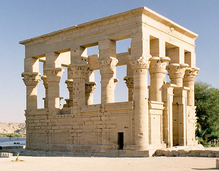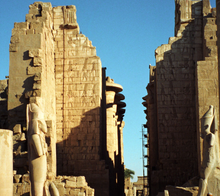Kiosk (Ancient Egypt)
The ancient Egyptian kiosk was a pavilion that was opened on several sides and was a special form of God's shadow and had the character of a sun chapel .
background
design type

The kiosk consisted of a rectangular system of columns , each connected by lintels . The entrance areas on both sides of the complex consisted mostly of two-door gates that were opened for processional parades and thus enabled unhindered passage. The massive columns were richly painted with hieroglyphics and sculptures:
- Lotus columns: capital with a stylized lotus blossom
- Papyrus pillars : wrapped in strips of papyrus
- Palm pillars: Their capitals resemble those of palm leaves
The capital is either closed like a bud and tapers towards the top (closed capital) or widens in a goblet shape (open capital).
Functions
The kiosk was not tied to any specific dimensions and was laid out according to its intended function. As a sacrificial shrine , the kiosk could be built on or between existing buildings or as a free-standing facility.
The alabaster kiosk in the Karnak Temple , which was built by Amenhotep I on the seventh pylon , achieved particular fame . Thutmose I completed the not quite finished southern part. The kiosk was seven meters long, three meters wide and a good four meters high. The doors were made of copper ore and gold . Amenophis I dedicated this kiosk to the sun god Amun-Re on the occasion of his Sedfest . The open building complex was supposed to enable direct contact for the renewal of rule associated with the Sedfest. Thutmose III. had this kiosk removed before Amenhotep III. Reused parts of it in the third pylon.
The kiosk was also used as a processional stop or barque sanctuary , for example at the royal Min or Opet festival .
See also
literature
- Franz-Jürgen Schmitz: Amenophis I. Gerstenberg, Hildesheim 1978, ISBN 3-8067-8032-3 , p. 83.

